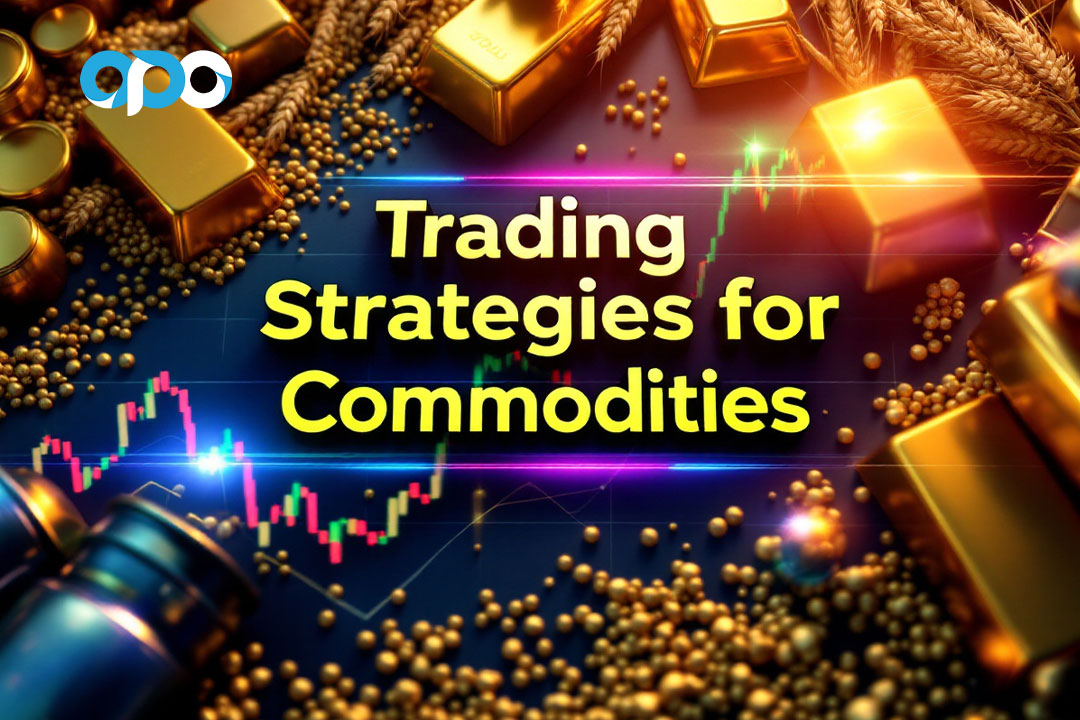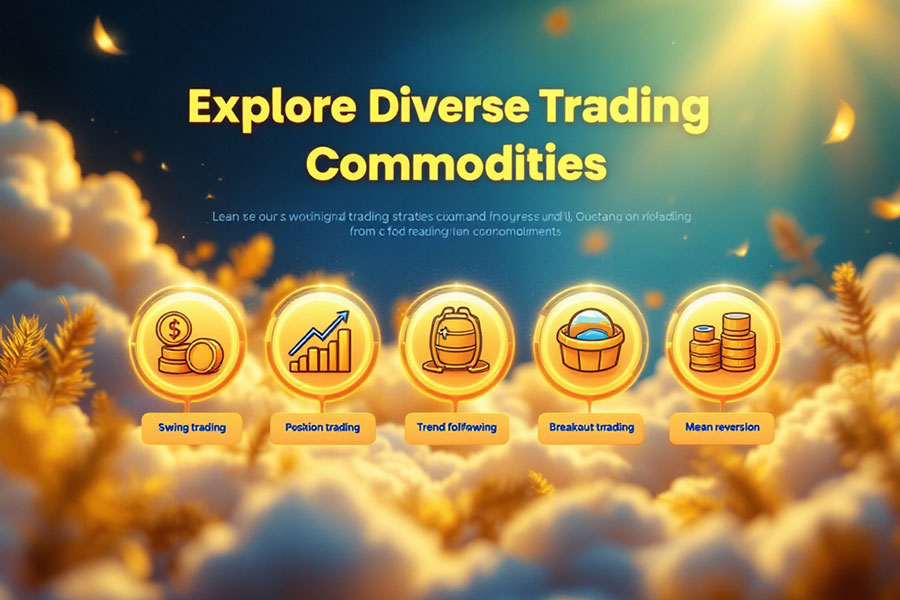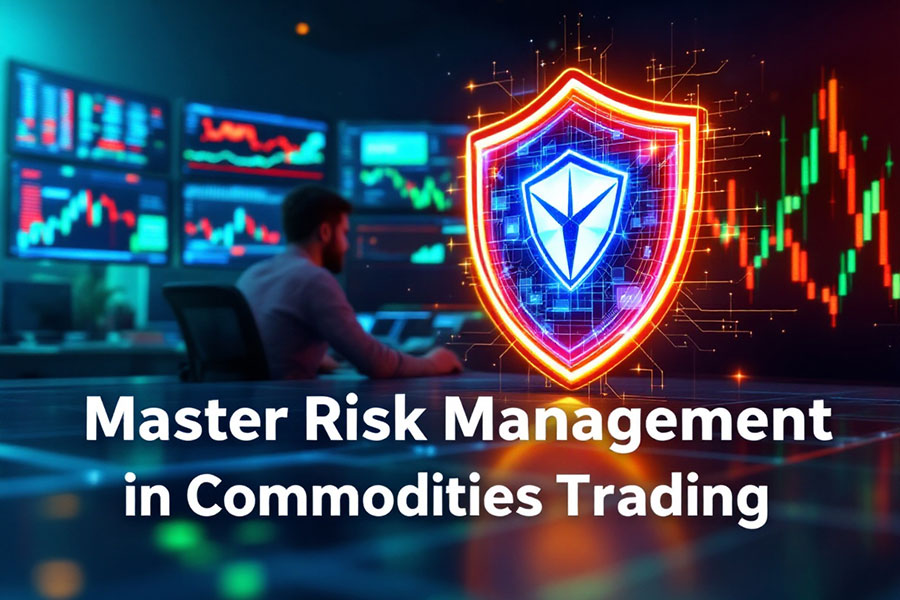When trading in the commodities market, the success of a trader often hinges on their ability to implement effective trading strategies. Understanding the various trading strategies for commodities is essential for navigating the often volatile and unpredictable commodity markets. In this guide, we’ll walk you through the best trading strategy for commodities and provide insights into how traders can optimize their strategies, minimize risk, and maximize profit.

The term “commodities” refers to physical goods like oil, gold, silver, wheat, and copper. These are typically raw materials or agricultural products that hold intrinsic value due to their widespread use in industries. Trading commodities has long been an essential part of the global economy, and the market offers diverse opportunities for traders looking to capitalize on price fluctuations. By developing a solid plan and selecting a strategy that aligns with your objectives, you can enhance your chances of success. This article also addresses the importance of risk management and advanced techniques to ensure long-term sustainability in commodity trading.
If you’re looking for a comprehensive strategy, whether using a forex trading broker or a commodities-specific platform, this guide will introduce you to everything from short-term tactics to long-term investments, advanced techniques, and ways to protect yourself from market volatility.
Overview of Commodities Trading and Its Significance

Commodities trading involves the buying and selling of physical assets such as crude oil, natural gas, gold, and agricultural products. These assets are traded on both spot markets, where immediate delivery takes place, and futures markets, where delivery is delayed. Commodities are an essential part of the global economy, with countries, corporations, and individual traders heavily reliant on them. Their price fluctuations can influence everything from the cost of consumer goods to the performance of stock markets.
As a trader, your role is to capitalize on these price movements, either by holding a position for a short period or betting on long-term trends. The commodities market is highly influenced by factors such as weather conditions, geopolitical tensions, and supply chain disruptions. This volatility makes commodities trading both risky and profitable, underscoring the need for a well-structured trading strategy.
Read More: 200 day moving average trading strategies
Why Having a Structured Trading Strategy is Crucial
The volatility of the commodities market requires traders to have a structured and disciplined approach. Without a proper trading strategy, it is easy to make impulsive decisions based on emotions, leading to significant financial losses. A strong trading strategy for commodities ensures that traders are guided by a set of rules and methodologies rather than reacting to market movements impulsively.
A structured strategy will typically involve both technical and fundamental analysis, a clear risk management framework, and predefined exit and entry points. Most importantly, traders should understand the market environment in which they are operating and adapt their strategies accordingly.
Types of Trading Strategies for Commodities

1. Swing Trading
Definition and Time Frame
Swing trading is a common strategy in the commodities market, where traders aim to capture short- to medium-term price movements. In this strategy, traders hold positions anywhere from a few days to several weeks, profiting from price “swings” within a broader trend. It’s an ideal approach for traders who prefer less market exposure than day trading but want more frequent trades than position trading.
Use of Technical Analysis for Short-Term Price Movements
Swing traders rely heavily on technical indicators such as moving averages, MACD (Moving Average Convergence Divergence), and RSI (Relative Strength Index) to predict price movements. By identifying momentum shifts, they can enter trades when price movements are at their peak or bottom, allowing them to capitalize on the small price fluctuations over short periods.
The use of swing trading in commodities allows traders to take advantage of temporary price corrections while maintaining a risk management plan to minimize losses in case of market reversals.
2. Position Trading
Long-Term Strategy Focusing on Market Trends
Position trading is a long-term trading strategy where traders aim to profit from sustained market trends over months or even years. This strategy requires a high level of patience as traders ignore short-term fluctuations, focusing instead on fundamental factors that influence long-term price trends.
Reliance on Fundamental Analysis
Unlike swing trading, position trading depends more on fundamental analysis than technical indicators. Traders carefully analyze macroeconomic factors, geopolitical events, and industry reports to determine the future direction of commodity prices. For example, oil traders might look at OPEC production reports, geopolitical tensions in oil-producing regions, and global demand forecasts to make informed decisions.
The advantage of position trading is that it reduces the time spent monitoring the market daily. However, it requires a larger amount of capital and a greater tolerance for short-term volatility.
3. Scalping
Ultra-Short-Term Strategy Targeting Minor Price Fluctuations
Scalping is the most aggressive trading strategy in commodities, focusing on profiting from minor price movements within very short time frames. Scalpers enter and exit positions multiple times throughout the day, aiming to make small profits that accumulate over time.
Frequent Trades to Capitalize on Bid-Ask Spreads
Scalpers focus on market inefficiencies, such as bid-ask spreads and small price fluctuations. The goal is to accumulate profits quickly by placing a high volume of trades throughout the day. Traders use advanced technical tools and indicators like candlestick patterns, Bollinger Bands, and short-term moving averages to make split-second decisions.
While scalping can be highly profitable, it also requires extensive market knowledge, quick decision-making skills, and a deep understanding of technical analysis.
4. Day Trading
Holding Positions for Several Hours to Days
Day trading involves opening and closing positions within the same day, taking advantage of intraday price movements. Unlike scalping, day traders hold positions for several hours but typically close out before the market closes, avoiding overnight risks.
Combination of Technical and Fundamental Analysis
Day traders rely on a combination of technical and fundamental analysis to identify opportunities within the trading day. They track economic data releases, earnings reports, and geopolitical news to predict short-term price movements.
By combining chart patterns and news events, day traders can capitalize on the volatility that occurs in response to market events, without the risk of holding positions overnight.
5. Trend Following
Capitalizing on Prolonged Price Movements
Trend following is a long-term strategy where traders attempt to profit by riding on the back of sustained price movements in a particular direction. This approach is based on the principle that “the trend is your friend” and involves entering trades that align with the overall market momentum.
Use of Moving Averages for Buy/Sell Signals
Moving averages, particularly the 50-day and 200-day moving averages, are key tools for trend followers. When the short-term moving average crosses above the long-term moving average, it generates a buy signal, and when it crosses below, it generates a sell signal. Traders who follow this strategy aim to stay in their trades as long as the trend continues, only exiting when signs of a reversal emerge.
6. Breakout Trading
Identifying Key Support and Resistance Levels
Breakout trading is based on the principle that price tends to make big moves after breaking out of a key level of support or resistance. This strategy involves identifying these key levels and placing trades when the price breaks through them.
Trading Based on Price Level Breakouts
Traders using breakout strategies set entry points just above resistance or below support levels, assuming that once the price breaks through, it will continue to move in that direction with increased momentum. This strategy is particularly effective in commodities markets, where price movements can be sharp and decisive after breakouts.
7. Mean Reversion
Assumption that Prices Will Return to Average Levels
Mean reversion is a strategy based on the assumption that commodities prices, like any other financial asset, will revert to their average over time. Traders look for instances where the price has deviated significantly from its average and place trades based on the expectation that it will eventually return to the mean.
Strategies for Buying Dips or Selling Spikes
For commodities, mean reversion traders might buy when prices fall significantly below their average or sell when prices spike above the norm. This strategy requires a good understanding of the commodity’s historical price range and the factors that might influence short-term price deviations.
Risk Management in Commodities Trading

Importance of Risk Assessment and Management Strategies
Commodities trading, while potentially lucrative, comes with substantial risks due to the volatility of these markets. Risk management is, therefore, an essential part of any successful commodities trading strategy. Failing to manage risk can lead to significant losses, especially in highly leveraged positions.
Techniques Such as Stop-Loss Orders and Position Sizing
Stop-loss orders are a fundamental tool in risk management, allowing traders to set a predetermined price at which their positions will be automatically closed. This minimizes the potential loss if the market moves against them.
Position sizing is another crucial aspect of risk management, as it helps traders allocate their capital wisely. By determining the right size for each trade based on the overall risk to their portfolio, traders can avoid overexposure to any single commodity.
Diversification Across Different Commodities
Diversification reduces risk by spreading investments across a variety of commodities. If one commodity underperforms, the loss can be offset by gains in another. Traders can diversify across sectors, such as energy, metals, and agriculture, to minimize exposure to sector-specific risks.
Advanced Trading Techniques

Leverage and Margin
Explanation of Leverage in Trading
Leverage allows traders to control larger positions than their account balance would otherwise permit. For instance, with 10:1 leverage, a trader can control $10,000 worth of commodities with only $1,000 in capital.
Risks Associated with Margin Trading
However, leverage also increases risk. While it can amplify profits, it can also magnify losses, potentially wiping out an account if the market moves against a highly leveraged position. Using leverage responsibly is key to maintaining a long-term, sustainable trading career.
Hedging Strategies
Definition and Purpose of Hedging in Commodity Markets
Hedging involves taking a position in a related asset to offset potential losses in the primary position. Traders often use futures contracts to hedge against price movements in the underlying commodity.
Examples of Hedging Techniques (e.g., Futures Contracts)
For example, an oil producer might use futures contracts to lock in a sale price for oil, protecting against a drop in oil prices. Hedging is especially useful for commodities that are prone to price swings due to unpredictable factors like weather or geopolitical events.
Developing a Trading Plan
Importance of a Structured Trading Plan
A successful trading career in commodities requires more than just a strategy—it requires a trading plan. A trading plan is a comprehensive outline that includes your entry and exit strategies, risk management rules, and a system for reviewing and adjusting your performance over time.
Key Components: Entry/Exit Points, Risk Management, Performance Review
The key components of a trading plan include clearly defined entry and exit points, based on your chosen strategy, as well as a detailed risk management framework. Regular performance reviews are crucial for refining and improving your approach over time.
Read More: 50 ema scalping strategy
Opofinance Services: ASIC-Regulated Broker with Cutting-Edge Features
When it comes to trading commodities and forex, selecting the right broker is crucial. Opofinance stands out as an ASIC-regulated broker, ensuring compliance with stringent regulatory standards. This regulation provides traders with the peace of mind that their funds and transactions are secure and transparent.

Key Features of Opofinance
- Advanced Trading Platform (MT5): Opofinance is featured on the MT5 brokers list, offering traders access to sophisticated tools for analyzing markets and executing trades swiftly. The platform supports advanced charting and technical analysis, ideal for both commodity and forex trading.
- Diverse Trading Instruments: With a broad selection of commodities, including oil, gold, and agricultural products, Opofinance enables traders to diversify their portfolios effectively. Additionally, it offers a range of currency pairs for those interested in forex trading.
- Social Trading Service: One of the standout features of Opofinance is its social trading service, allowing users to follow and replicate the strategies of successful traders. This feature is particularly beneficial for beginners looking to learn from experienced professionals.
- Secure Deposits and Withdrawals: Opofinance provides a variety of safe and convenient deposit and withdrawal methods, ensuring a seamless experience for traders. Fast processing times mean you can access your funds quickly and efficiently.
- Comprehensive Risk Management Tools: The broker offers essential risk management features, including stop-loss and take-profit orders, allowing traders to protect their investments in volatile markets.
With its regulatory framework, advanced tools, and commitment to transparency, Opofinance is an excellent choice for traders looking to succeed in commodities and forex markets.
Conclusion
In commodities trading, having a solid strategy is essential for achieving long-term success. The various trading strategies for commodities discussed in this article—from swing trading to trend following—provide valuable frameworks for navigating market volatility. Understanding how to manage risk is equally important, as it protects your capital and sustains your trading journey.
A well-defined trading plan incorporating your entry and exit strategies, risk management rules, and regular performance reviews can significantly enhance your trading effectiveness. Choosing a reputable broker like Opofinance further strengthens your trading foundation by providing access to advanced tools, diverse assets, and reliable support.
Ultimately, the path to success in commodities trading involves continuous learning, adaptation, and disciplined execution of your chosen strategies. By combining a structured approach with the right resources, you can increase your chances of thriving in the dynamic world of commodities.
What commodities are best suited for swing trading?
Swing trading works well with commodities that experience frequent price fluctuations over the short term, such as oil, gold, and silver. These commodities often have well-established trends, making them ideal for traders who rely on technical analysis to capitalize on price swings.
Is day trading commodities riskier than other forms of trading?
Day trading commodities can be riskier due to the market’s volatility and the need for constant monitoring. However, traders who use proper risk management tools like stop-loss orders and position sizing can mitigate some of these risks. It requires significant experience and discipline to manage the rapid price movements typical in day trading.
How can I diversify my commodity trading portfolio?
Diversification in commodities trading involves spreading investments across different asset classes such as energy (oil, natural gas), metals (gold, silver), and agricultural products (wheat, coffee). This reduces the risk of exposure to a single sector’s volatility and helps balance potential losses across multiple commodities.







